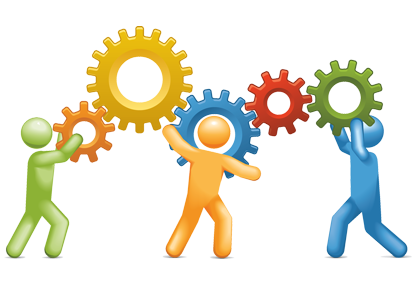Often times, people use the word ‘group’ and ‘team’ interchangeably. However there is a fine, yet important line that differentiates the two. According to the Pearson Seventh Canadian Edition textbook Organizational Behaviour: Concepts, Controversies, Applications, a group is defined as “Two or more people with a common relationships”. On the other hand, a team is defined as “A small number of people who work closely towards a common objective and are accountable to one another”. Therefore the necessity of a common objective, seen in teams facilitates an environment for “Dreamwork” to be fostered.
As seen in this clip from The Big Bang Theory, many organizational behaviour components of teamwork are addressed. This scene exemplifies the complexity of communication, conflict and negotiation within a team. Their common objective is to plan a night out accordingly to ensure that they 1. Find an adequate restaurant to eat at 2. Arrive on time to watch a movie at the theaters and 3. Ensure that they have the snacks such as “icies” to enjoy the movie. However, many obstacles, such as time management are encountered throughout their collaboration process . Overall, it is evident that the benefits of teamwork are resource pooling as each team member has different insights and skill sets to offer. For example, in this scene, Raj is the imaginative team member who offers alternative ideas, whereas Sheldon is a realist who questions each decision or idea that is presented. Thus, the cost of teamwork and collaboration is the overwhelm of opinions which can lead to unproductive or time consuming meetings.
Looking closely at Sheldon’s contribution to the team, he listens to each members input, yet is quick to reply with a remark that shuts their ideas down. This situation was similar to an activity that was assessed in our Comm 290 class called “Yes, but…”.  The objective of this activity was to create a plan that our OB group would partake in. Once a general idea for the plan had been established, each member could add details to this plan, by saying “Yes, but…”. This activity mimics the negative approach Sheldon took in collaborating with his friends. As experienced in this OB class activity and as seen in this clip, the “but” in collaborative work dampens progress. Although the “yes” at the start of the sentence is ensuring, the “but” cancels the tentative idea or plan that was initially created.
The objective of this activity was to create a plan that our OB group would partake in. Once a general idea for the plan had been established, each member could add details to this plan, by saying “Yes, but…”. This activity mimics the negative approach Sheldon took in collaborating with his friends. As experienced in this OB class activity and as seen in this clip, the “but” in collaborative work dampens progress. Although the “yes” at the start of the sentence is ensuring, the “but” cancels the tentative idea or plan that was initially created.
An alternative approach that was assessed in our OB class was by having each member respond with “Yes, and…”. The addition of the “and” eliminated possible borders for our plan and allowed for our group to collectively come closer to a common goal. Therefore, if Sheldon utilized the “Yes, and..” approach, he would have been on the same page as Leonard, Raj and Howard in planning their night and would not have been left behind at the end of the scene.
Ultimately, conflict is inevitable in teamwork, however to ensure that a positive outcome is achieved, negotiation through communication must be implemented.These fundamental tools are not only used in teamwork scenarios seen on T.V or in class but are also present in the business world. Due to the fact that a business is essentially a team working towards a common goal, the same obstacles that may present in teamwork in class are also present in the workplace. This statement is corroborated in a Harvard Business Review about (Links to an external site.) “The Secrets of Great Teamwork” which states that having a shared mindset among team members is essential for collaboration and negotiation.
Thus, to address the title of this discussion: No, Group Work Does Not Make The Dreamworks due to the inexistence of a of a shared mindset and common objective that are only seen within teams.
Therefore it is “Teamwork (that) Makes The Dreamwork”*.
*quote by John C. Maxwell.

Sources:
Mortensen, M. H. (2016, May 16). The Secrets of Great Teamwork. Retrieved February 23, 2018, from https://hbr.org/2016/06/the-secrets-of-great-teamwork
Hooton, M. (2015, June 10). Effective Collaboration – Big Bang Theory. Retrieved February 22, 2018, from https://www.youtube.com/watch?v=tSMT1ut8xgY
Teamwork [Letters and Hands]. (n.d.). Retrieved from http://vorkspace.com/blog/wp-content/uploads/iStock_000026543869Small_banner.jpg.
Collaboration [Digital image]. (n.d.). Retrieved from https://www.questteam.com/classroom/images/gear_team_420.png